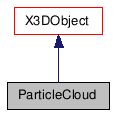Detailed Description
This class represents a Particle Cloud in a Softimage scene.
All particle-specific functionality is exposed via the ParticleCloudPrimitive, which is accessible by calling X3DObject::GetActivePrimitive.
Normally a ParticleCloud is created with the deprecated CreateParticleCloud command. Alternatively, X3DObject::AddParticleCloud will create a basic particle cloud suitable for custom simulations driven by a custom particle operator.
- See also:
- Particle, ParticleCloud
- Deprecated:
- 8.0 (2010) Legacy particles are only kept for backward compatibility.
- Example:
using namespace XSI; Application app ; CValueArray args(2) ; CValue outArg; //Move ahead to 1 second on the timeline args[0] = L"PlayControl.Current" ; args[1] = 30l ; app.ExecuteCommand( L"SetValue", args, outArg ) ; // Create a particle cloud using CreateParticleCloud command // This automatically creates a particle type and a particle emitter object args[0] = app.GetActiveSceneRoot().GetRef() ; //Where to add the particle cloud args[1] = L"grid" ; // Type of emitter object app.ExecuteCommand( L"CreateParticleCloud", args, outArg ) ; CValueArray & NewParticleClouds = outArg ; ParticleCloud myCloud = NewParticleClouds[0] ; myCloud.PutName( CString( L"CloudDemo" ) ) ; // Particles are accessed via the Primitive ParticleCloudPrimitive myParticlePrim = myCloud.GetActivePrimitive() ; app.LogMessage( L"There are " + CValue(myParticlePrim.GetCount()).GetAsText() + L" particles" ); // Get access to the particle type associated with the cloud CRefArray myParticleTypes = myParticlePrim.GetParticleTypes() ; Property myParType = myParticleTypes[0] ; app.LogMessage( L"Associated particle type " + myParType.GetFullName() ) ;
#include <xsi_particlecloud.h>

Public Member Functions | |
| ParticleCloud () | |
| ~ParticleCloud () | |
| ParticleCloud (const CRef &in_ref) | |
| ParticleCloud (const ParticleCloud &in_obj) | |
| bool | IsA (siClassID in_ClassID) const |
| siClassID | GetClassID () const |
| ParticleCloud & | operator= (const ParticleCloud &in_obj) |
| ParticleCloud & | operator= (const CRef &in_ref) |
Constructor & Destructor Documentation
| ParticleCloud | ( | ) |
Default constructor.
| ~ParticleCloud | ( | ) |
Default destructor.
| ParticleCloud | ( | const CRef & | in_ref | ) |
Constructor.
- Parameters:
-
in_ref constant reference object.
| ParticleCloud | ( | const ParticleCloud & | in_obj | ) |
Copy constructor.
- Parameters:
-
in_obj constant class object.
Member Function Documentation
| bool IsA | ( | siClassID | in_ClassID | ) | const [virtual] |
Returns true if a given class type is compatible with this API class.
- Parameters:
-
in_ClassID class type.
- Returns:
- true if the class is compatible, false otherwise.
Reimplemented from X3DObject.
| siClassID GetClassID | ( | ) | const [virtual] |
| ParticleCloud& operator= | ( | const ParticleCloud & | in_obj | ) |
Creates an object from another object. The newly created object is set to empty if the input object is not compatible.
- Parameters:
-
in_obj constant class object.
- Returns:
- The new ParticleCloud object.
| ParticleCloud& operator= | ( | const CRef & | in_ref | ) |
Creates an object from a reference object. The newly created object is set to empty if the input reference object is not compatible.
- Parameters:
-
in_ref constant class object.
- Returns:
- The new ParticleCloud object.
Reimplemented from X3DObject.
The documentation for this class was generated from the following file:
